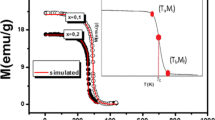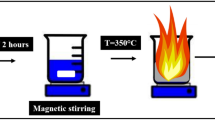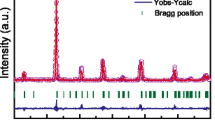Abstract
Magnetocaloric properties of the Eu0.5Sr0.5CoO3 system near a phase transition from a ferromagnetic to a paramagnetic state are investigated. It is shown that the magnetic entropy change (ΔS M ) peak spanning over a broad range of temperature leads to a remarkably wide working temperature region, yielding a significant performance in terms of refrigerant efficiency. Moreover, ΔS M distribution is very uniform, which is desirable for Ericsson-cycle magnetic refrigerator. Eu0.5Sr0.5CoO3 can be used as a working material of an apparatus based on the active magnetic regenerator cycle that cools hydrogen gas.
Similar content being viewed by others
Avoid common mistakes on your manuscript.
1 Introduction
The refrigeration technology, based on the magnetocaloric effect (MCE) or electrocaloric effect, has been demonstrated as a promising alternative technology to classical refrigeration (air conditioning, refrigeration, liquefaction of gases, etc.) and has a great potential to compete successfully with compression and relaxation of the gases for refrigeration [1–12]. This refrigeration provides an efficient and environment-friendly solution to cooling. It is more efficient, inexpensive, and environmentally friendly for replacing the current refrigerators using greenhouse gases that are harmful to environment and contributing to global warming. In principle, magnetic refrigeration is based on the magnetocaloric effect, which is the thermal response of a magnetic solid to the variation of a magnetic field in an adiabatic process.
Perovskite-related cobalt oxides Ln1−x M x CoO3 (Ln: lanthanides, M: alkaline-earth metals) have attracted much interest because of the existence of spin-state transitions and the unusual magnetic properties they exhibit [13].
In this paper, theoretical work on magnetization versus temperature in different magnetic fields for the Eu0.5Sr0.5CoO3 is presented. A phenomenological model for simulation of magnetization dependence on temperature variation is used to predict magnetocaloric properties such as magnetic entropy change, heat capacity change, temperature change, and relative cooling power.
2 Theoretical Considerations
According to the phenomenological model [14], the dependence of magnetization on variation of temperature and Curie temperature T c is represented by
where M i is an initial value of magnetization at ferromagnetic–paramagnetic transition, and M f is a final value of magnetization at ferromagnetic–paramagnetic transition as shown in Fig. 1, where \(A = \frac{2(B - S_{c})}{M_{i} - M_{f}}\), B is the magnetization sensitivity \(\frac{dM}{dT}\) at ferromagnetic state before transition, S c is the magnetization sensitivity \(\frac{dM}{dT}\) at Curie temperature T C , and \(C = (\frac{M_{i} + M_{f}}{2}) - BT_{C}\).
Equation (1) is determined by the physical mechanism that the magnetic moments can be increased by decreasing the temperature. At temperatures well below the Curie point, the electronic magnetic moments of a ferromagnetic specimen are essentially all lined up, when regarded on a microscopic scale.
A magnetic entropy change of a magnetic system under adiabatic magnetic field variation from 0 to final value H max is available by

The foundation of large magnetic entropy change is attributed to high magnetic moment and rapid change of magnetization at T c . A result of Eq. (2) is a maximum magnetic entropy change ΔS max (where T=T C ), which can be evaluated as in the following equation:
Equation (3) is an important equation for taking into consideration the value of the magnetic entropy change to evaluate magnetic cooling efficiency with its full-width at half-maximum.
A determination of full-width at half-maximum δT FWHM can be carried out as follows:
This equation gives a full-width at half-maximum magnetic entropy change contributing for estimation of magnetic cooling efficiency as follows. The magnetic cooling efficiency is estimated by considering the magnitude of magnetic entropy change ΔS M and its full-width at half-maximum (δT FWHM). The product of −ΔS max and δT FWHM is called the relative cooling power (RCP) based on magnetic entropy change:

The magnetization-related change of the specific heat is given by
According to this model [14], ΔC P,H can be rewritten as

A temperature change of a magnetic system under adiabatic magnetic field variation from 0 to H max can be written in the form

C p is a heat capacity per mole at constant magnetic field.
From this phenomenological model one can easily assess the values of δT FWHM, |ΔS|max, RCP, and ΔT for Eu0.5Sr0.5CoO3 under magnetic field variation.
3 Theoretical Work
To evaluate the magnetocaloric effect in Eu0.5Sr0.5CoO3, a series of numerical calculations were made around the ferromagnetic transition with parameters as displayed in Table 1. A heat capacity C p =550 J/kg K for Eu0.5Sr0.5CoO3. Figure 2 shows the magnetization versus temperature in different applied magnetic fields for Eu0.5Sr0.5CoO3. The symbols represent experimental data from Ref. [15], while the dashed curves represent the modeled data using the model parameters given in Table 1. It is seen that for the given parameters, the results of calculation are in a good agreement with the experimental results. Furthermore, Figs. 3–5 show the temperature dependence of change of the magnetic entropy, specific heat, and temperature, respectively, subject to different applied field changes. A peak in the entropy change (ΔS max) occurs near T C in each applied field change.
Magnetization in different applied magnetic fields for the Eu0.5Sr0.5CoO3 versus temperature. The dashed curves are modeled results, and symbols represent experimental data from Ref. [15]
The values of maximum magnetic entropy change, full-width at half-maximum, and relative cooling power at different magnetic fields for Eu0.5Sr0.5CoO3 are calculated by using Eqs. (3)–(5), respectively, and tabulated in Table 2. Furthermore, the maximum and minimum values of specific heat change for each sample are determined from Fig. 4.
Both ΔS M and ΔT reflect a fundamental importance on the understanding of the behavior of the MCE, and these terms can be approximately estimated using Eqs. (2) and (8), respectively.
The largest entropy change value of 1.08 J/kg K occurs at T=154 K for ΔH=4 T. The peaks broaden, increasing the working temperature range for devices and maintaining refrigeration capacity, a figure of merit in magnetocaloric materials that depend on both the height −ΔS M and δT FWHM of the peak. The RCP reached sizable value of 92.59 J/kg for ΔH=4 T. Moreover, ΔS M distribution of the Eu0.5Sr0.5CoO3 is uniform. This feature is desirable for an Ericsson-cycle magnetic refrigerator [16]. ΔT is presented in Fig. 5. ΔT undergoes an abrupt rise at T C , and the temperature range of the large ΔT expanded with increasing magnetic field. Figure 5 indicates that the temperature range between 20 and 300 K can be covered using the Eu0.5Sr0.5CoO3 system. −ΔS M (T) peaks span over a wide temperature region, which can significantly improve the global efficiency of the magnetic refrigeration. To investigate more precisely this issue, the refrigerant capacity RC has been computed, which is considered to be the most important factor for assessing the usefulness of a magnetic refrigerant material. The RC values in Table 2 were derived from \(\mathrm{RC} = \int_{T_{C} - \frac{\delta {T}_{\mathrm{FWHM}}}{2}}^{T_{C} + \frac{\delta {T}_{\mathrm{FWHM}}}{2}} \Delta S_{M}\,dT\) [17, 18].
When increasing ΔH, δT FWHM increases up to 85.73 K for ΔH=4 T. Thus, in spite of a modest ΔS max, the RC remains appreciable owing to the large δT FWHM value.
The present Perovskite cobalt oxide Eu0.5Sr0.5CoO3 has promising ΔT values for use as magnetic refrigerants. It can be used as a working material of an apparatus based on the active magnetic regenerator cycle that cools hydrogen gas from the temperature of liquid natural gas (112 K) to nearly the boiling point of hydrogen (20 K).
In conclusion, Eu0.5Sr0.5CoO3 system near a phase transition from a ferromagnetic to a paramagnetic state shows good magnetocaloric properties. The −ΔS M peak spanning over a broad range of temperature leads to a remarkably wide working temperature region, yielding a significant performance in terms of refrigerant efficiency. Moreover, ΔS M distribution is very uniform, which is desirable for Ericsson-cycle magnetic refrigerator. Eu0.5Sr0.5CoO3 can be used as a working material of an apparatus based on the active magnetic regenerator cycle that cools hydrogen gas.
References
Hamad, M.A.: Theoretical work on magnetocaloric effect in La0.75Ca0.25MnO3. J. Adv. Ceram. 1(4), 290–295 (2012)
Hamad, M.A.: Magnetocaloric effect in (001)-oriented MnAs thin film. J. Supercond. Nov. Magn. (2013). doi:10.1007/s10948-013-2254-9
Hamad, M.A.: Philos. Mag. Lett. (2013). doi:10.1080/09500839.2013.779759
Hamad, M.A.: Detecting giant electrocaloric properties of ferroelectric SbSI at room temperature. J. Adv. Dielectr. doi:10.1142/S2010135X13500082
Hamad, M.A.: Theoretical investigations on electrocaloric properties of PbZr0.95Ti0.05O3 thin film. Int. J. Thermophys. (2013). doi:10.1007/s10765-013-1457-4
Hamad, M.A.: Magnetocaloric properties of La0.6Ca0.4MnO3. J. Therm. Anal. Calorim. (2012). doi:10.1007/s10973-012-2723-6
Hamad, M.A.: Theoretical work on magnetocaloric effect in ceramic and sol-gel La0.67Ca0.33MnO3. J. Therm. Anal. Calorim. (2012). doi:10.1007/s10973-012-2505-1
Hamad, M.A.: AIP Adv. 3, 032115 (2013)
Hamad, M.A.: Magnetocaloric effect in Ge0.95Mn0.05 films. J. Supercond. Nov. Magn. (2012). doi:10.1007/s10948-012-1762-3
Hamad, M.A.: Theoretical investigations on electrocaloric properties of relaxor ferroelectric 0.9PbMg1/3Nb2/3O3–0.1PbTiO3 thin film. J. Comput. Electron. (2012). doi:10.1007/s10825-012-0414-y
Hamad, M.A.: Appl. Phys. Lett. 102, 142908 (2013)
Hamad, M.A.: Simulation of magnetocaloric effect in La0.7Ca0.3MnO3 ceramics fabricated by fast sintering process. J. Supercond. Nov. Magn. (2013). doi:10.1007/s10948-013-2260-y
Yoshii, K., et al.: Mater. Res. Bull. 36, 1447 (2001)
Hamad, M.A.: Magnetocaloric effect of perovskite manganites Ce0.67Sr0.33MnO3. J. Supercond. Nov. Magn. (2013). doi:10.1007/s10948-013-2124-5
Li, F., Fang, J.: J. Magn. Magn. Mater. 324, 2664 (2012)
Pecharsky, V.K., Gschneidner, K.A., Jr.: J. Magn. Magn. Mater. 200, 44 (1999)
Hamad, M.A.: Magnetocaloric effect in nanopowders of Pr0.67Ca0.33Fe x Mn1−x O3. J. Supercond. Nov. Magn. (2013). doi: 10.1007/s10948-013-2244-y
Hamad, M.A.: Magnetocaloric effect in La1−x Cd x MnO3. J. Supercond. Nov. Magn. (2013). doi:10.1007/s10948-013-2189-1
Author information
Authors and Affiliations
Corresponding author
Rights and permissions
About this article
Cite this article
Hamad, M.A. Magnetocaloric Effect of Perovskite Eu0.5Sr0.5CoO3 . J Supercond Nov Magn 27, 277–280 (2014). https://doi.org/10.1007/s10948-013-2270-9
Received:
Accepted:
Published:
Issue Date:
DOI: https://doi.org/10.1007/s10948-013-2270-9









